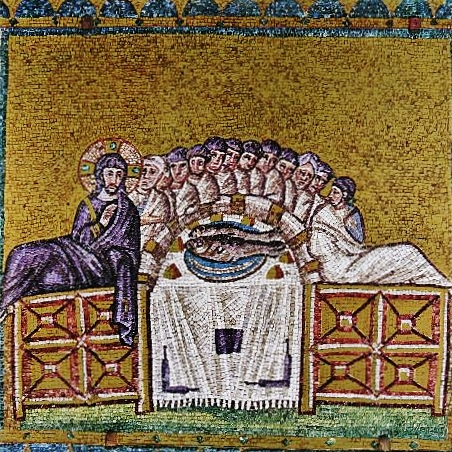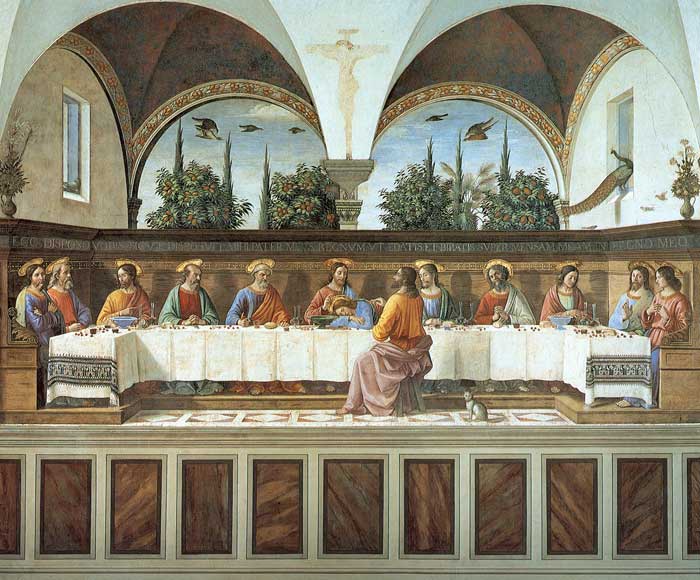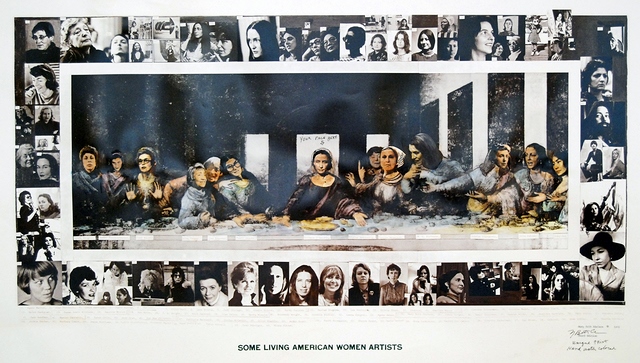The Christian observance of the Last Supper is on Maundy Thursday this year, on March 28. Jesus and his disciples celebrated Jewish Pesach (Passover), the eve of the Israelite exodus from Egypt. The tradition was soon established by the early Christians who, before they had buildings for worship, observed the Last Supper weekly in their homes.

One of the earliest representations of the Last Supper was found in the Catacomb of Priscilla in a square chamber known as the Greek Chapel. “Breaking of the bread” (2nd century CE) (fresco) was painted on an of arch over an altar-tomb where the sacrament was performed. The images of the fresco are faint. However, experts have described the scene of seven people reclining on banqueting couches in the manner of the Romans. The Roman Catholic church holds that six men and one woman are present. The figure at the left, slightly separated from the group, is breaking bread. A two-handled cup is set on the table in front of him, along with two large platters containing two fish and five loaves. At either side of the table are baskets filled with loaves of bread.
Early Christians believed in burial of the dead, as opposed to the Roman practice of cremation. The catacombs, along roads outside the city of Rome, contain examples of Early Christian art. The people were poor, and they could not afford artists of high quality. Therefore, the images were primitive. The frescoes were underground, lit only by candle or torch. The atmosphere was unpleasant because of the odor of new burials.

“Last Supper” (6th Century)
“Last Supper” (6th Century) (mosaic) (Basilica of St Apollinaire Nuovo, Ravenna, Italy) illustrates the continued development of Christian art. By the 6th Century, Christianity had become the dominant religion of Italy. Ravenna was the second major capital of the Christian world after Constantinople, in what was then Greece. St Apollinare Nuovo was reconstructed by the Byzantine emperor Justinian I. “Last Supper” is one of 13 mosaics telling the story of the of the passion through the resurrection. Christ was depicted wearing a robe of royal purple, a dye that was very rare and costly. Royal purple was forbidden to all but royalty. Christ also wears a gold trinity halo with three large green emeralds. The twelve disciples recline in Roman style around the table. The anatomical depiction was slightly improved over the earlier fresco, but three-dimensional space was several hundred years in the future. Peter, with the white hair and beard, has been established as being beside Christ. The twelfth figure, barely visible beside Peter, is Judas. Two fish on a plate and seven triangular loaves of bread are set on the white tablecloth. The scene, as in almost all Byzantine mosaics, is placed in front of a solid gold wall. The table is placed on a green lawn.

“Last Supper” (1486)
In 15th Century Italy, Renaissance artists developed a complete knowledge of anatomy and perspective to create realistic images. “Last Supper” (1486) (fresco) (Refectory wall of San Marco, Florence) (160”x320”) was painted by the Florentine master Dominico Ghirlandaio (1448-1494). Applying linear perspective, first realized c.1415 by Florentine painter and architect Filippo Brunelleschi, Ghirlandaio painted the twelve disciples and Christ seated, uncrowded, and together, at a long table. The table is set with wine glasses, loaves of bread, plates, and other food items. The disciples’ feet are visible under the edge of the elaborate woven tablecloth. The tradition of placing Judas at the opposite side of the table had been established. Rather than sharing the bread and wine, Jesus has just announced that one of the disciples would betray Him. The disciples, realistically represented as individuals, react to the pronouncement. At Christ’s right side, Peter holds his dinner knife in his fist, and the youngest disciple John is asleep.
Ghirlandaio sets the scene in a room of an Italian Renaissance villa, under an arched roof with a view to the outdoor garden. Four trees are orange trees, the oranges recognized as the Medici family emblem. The six cypress trees were, and remain, a symbol of Tuscany. Tall and stately, the cypress trees can live for as many as 2000 years, and are the symbol of immortality. Their pleasant sent was thought to ward off evil and aid in the passage to the after-life. Another symbol of immortality is the peacock. One is perched in the window at the right. The peacock’s body did not seem to decay, and was considered a symbol of immortality. Peacocks were represented in Early Christian catacombs. Ghirlandaio painted several versions of the Last Supper, but only this one has a cat. It sits on the floor behind Judas and looks out at the viewer. Placed behind Judas, the cat was thought to represent Satan.

“Some Living American Women Artists” (1972)
“Some Living American Women Artists” (1972) (collage) (28.25’’x42”) (MoMA) is by Mary Beth Edelson (1922-2021), an active participant in the women’s movement. Using Leonardo’s iconic “Last Supper” as a guide, she placed twelve photographs of contemporary women artists in the place of the disciples. She placed Georgia O’Keeffe in the position of Christ, but she did not designate any of the women as Judas. The twelve, starting from the left, are Lynda Benglis, Helen Frankenthaler, June Wayne, Alma Thomas, Lee Krasner, and Nancy Graves. Continuing beyond O’Keeffe are Elaine de Kooning, Louise Nevelson, M.C. Richards, Louise Bourgeois, Lila Katzen. and Yoko Ono. Photographs of 69 more contemporary women artists are placed in the border.
Women artists are still working to achieve equality with men in the art market. This work by Edelson’s was a criticism of the politics of the art world, but it also was a great tribute to her contemporary women artists. The original piece was then produced as a poster, and it can be found in the collections of many museums. It has become iconic in its own right.
Beverly Hall Smith was a professor of art history for 40 years. Since retiring with her husband Kurt to Chestertown in 2014, she has taught art history classes at WC-ALL. She is also an artist whose work is sometimes in exhibitions at Chestertown RiverArts and she paints sets for the Garfield Center for the Arts.


Write a Letter to the Editor on this Article
We encourage readers to offer their point of view on this article by submitting the following form. Editing is sometimes necessary and is done at the discretion of the editorial staff.